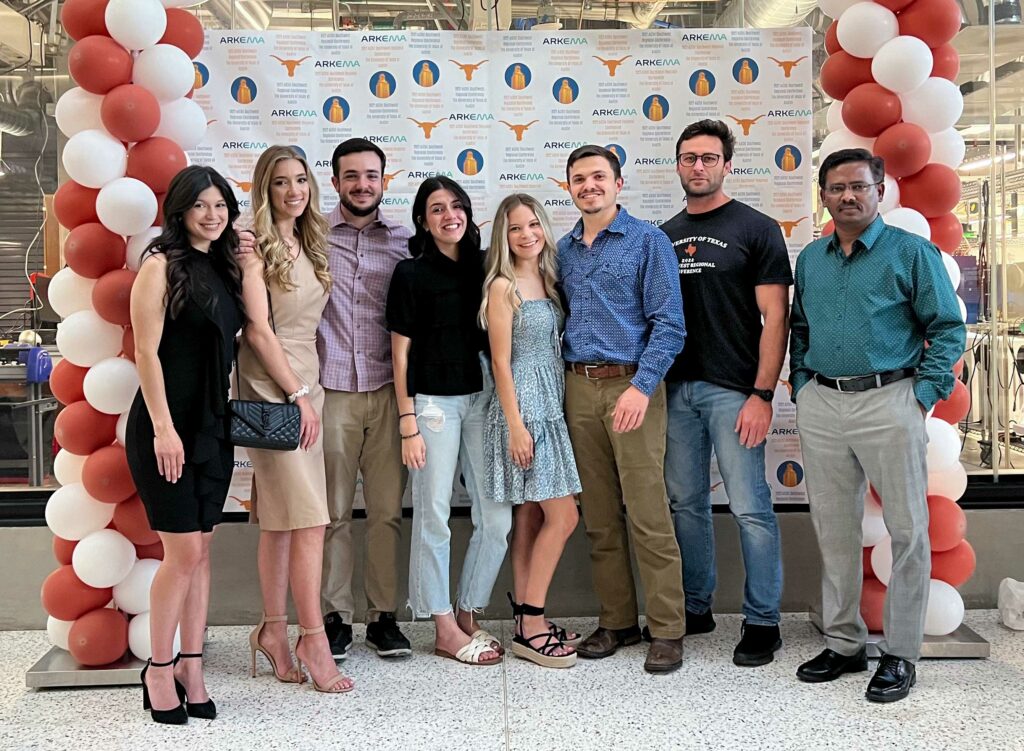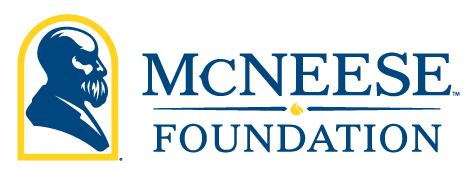
A team of chemical engineering majors from McNeese State University recently took first and second place in the Chem-E-Car Competition at the American Institute of Chemical Engineers Southwest Regional Conference 2022, hosted this year by the University of Texas at Austin.
The Chem-E-Car Competition is an international competition that challenges students to design and construct a small car that is self-propelled by a chemical energy source and both powered and stopped through chemical reactions.
The team from McNeese – composed of team captain Claude LaHaye, Alicia Vieira Claudio, Lauren Blood, Carson Smith, Paige Daboval, Ethan Cooley and Lindsey Priola – used zinc-air batteries as the power source for its car and an iodine clock reaction as the stopping mechanism. The car was built using a 3-D printer and programmed with an Arduino programming board.
“The car has a photocell and iodine clock that tells the car when to stop,” says LaHaye. “When the iodine clock goes from clear to black, the light can’t pass through the fluid anymore, and that tells the breaker to shut off and stops the car.”
There are two components to the competition. First, teams present a poster detailing the car’s engineering and the safety aspects of the design before pitting their cars against the other teams in a contest to see whose car will stop closest to a designated target. Contestants are told the distance of the target just one hour before the competition starts, a limit that changes each year.
“This year the target distance was set at 22.5 meters so we only had an hour to figure out our chemicals’ concentrations and the necessary design calculations to make the iodine clock reaction,” LaHaye says.
In the poster presentation, McNeese received first place. With two runs allowed on the second stage, the McNeese car stopped first at about 8 feet away from the line, and then 3 feet, landing them second place.
“That was really exciting,” says LaHaye. “The whole team was really pumped that we did so well.”
This was the first time McNeese sent a team to the competition in over a decade. LaHaye attributes the team’s success to a collective effort, as well as the encouragement and support of faculty adviser for the project, associate professor of chemical engineering Dr. Ramalingam Subramaniam.
“We’ve been testing, conducting experiments and really working hard for the past three months to make this happen – some people have worked on the poster, some have worked on the car and the experiments. It’s really been a team effort,” LaHaye says. “Dr. Subramaniam really helped us along the way and made sure we had what we needed. It definitely wouldn’t have been possible without him.”
“I realized what an excellent group of students I have and that all they really needed was a little bit of a push,” says Subramaniam. “The group did a really great job all the way. Individually each member of the team has a unique talent, but when they come together, they really can achieve so much. This is the best team I have come across in the last decade to demonstrate team building and project management.”
Subramaniam adds that opportunities like the Chem-E-Car Competition give students the chance to apply their fundamental understanding of chemical engineering into action in new and unexpected ways.
“Our students are putting theory into application,” he says. “They have some experience through laboratory courses but this teaches them to go beyond the text and learn the skill of design and troubleshooting. We gave our students the guidelines for what they need to accomplish, but beyond that, they have to find the sources for the chemical reactions they need and figure out how to put the pieces together and make sure it’s safe. That’s what chemical engineers do in real life, so they’re thinking like experienced chemical engineers during this whole process.”
LaHaye adds that this project has not only given them the chance to learn more about different power sources and 3D designing but also about leadership, management and teamwork. Delegating tasks, creating and maintaining deadlines and keeping everyone motivated were some of the non-technical challenges the team faced – especially when it looked like the project was on the cusp of failure just a week before the competition.
“We were at a point where it was kind of a last-ditch effort with the batteries, and when they didn’t work, I thought, ‘Well, that’s it.’ But the rest of the team wanted to keep going and really motivated me to keep trying, and it turned out that it was just a faulty test,” LaHaye says. “I’m really thankful for the team and that we persevered.”
The team has qualified to go to the national competition in Phoenix in November where it will have a shot at the national title and the chance to professionally network with teams from around the world, as well as representatives from sponsoring companies.
With his senior year and MCAT coming up, LaHaye says that he’ll be working to teach the next crop of Chem-E-Car engineers to take the reins and keep participation in the competition going.
“We can’t wait to try again next year and try new designs,” he says. “We learned a lot from competing and we’re excited to apply those lessons.”



